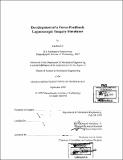Development of a force-feedback laparoscopic surgery simulator
Author(s)
Ben-Ur, Ela
DownloadFull printable version (12.99Mb)
Other Contributors
Massachusetts Institute of Technology. Dept. of Mechanical Engineering.
Advisor
J. Kenneth Salisbury, Jr.
Terms of use
Metadata
Show full item recordAbstract
The work presented here addressed the development of an electro-mechanical force-feedback device to provide more realistic and complete sensations to a laparoscopic surgery simulator than currently available. A survey of the issues surrounding haptic (touch) displays and training for laparoscopic or "keyhole" procedures was performed. A number of primary and secondary sources including surgeon consultation , operating room observations, and task analyses were used to accumulate a list of needs. Subsequent requirements analysis translated these into a set of specifications for the kinematics, dynamics and actuators, and configuration of the device. These suggested a design with five actuated axes (pitch and yaw about the entrance to the abdomen, insertion, rotation about the tool axis, and gripper feedback) amenable to a configuration including two actuated tools in a lifelike torso. These specifications were the basis for the generation and selection of design concepts. The PHANTOM haptic interface from Sensable Devices was chosen from among a number of existing devices and original designs to actuate the pitch, yaw, and insertion degrees of freedom. A separate end effector actuator was specified to supply feedback to the handle rotation and gripper. Mechanisms were proposed for each of these axes; a linear cable capstan was selected for the gripper and a cable capstan/drum for the rotation. The kinematics, bearings, transmissions, and user interface for both axes were designed in detail, and first- and second generation prototypes were built. The finished devices were integrated with the PHANTOM hardware, electronics, and software. Performance and design evaluations were performed, and plans for future device improvements and user studies were outlined.
Description
Thesis (S.M.)--Massachusetts Institute of Technology, Dept. of Mechanical Engineering, 1999. Includes bibliographical references (p. 77-78).
Date issued
1999Department
Massachusetts Institute of Technology. Department of Mechanical EngineeringPublisher
Massachusetts Institute of Technology
Keywords
Mechanical Engineering.